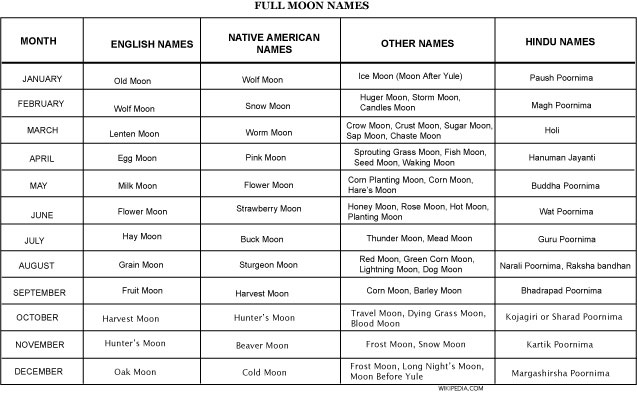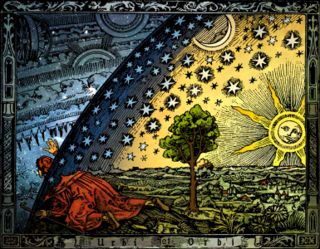The Earth’s Moon is a great teacher and aid when time for spell work. Depending on the spell to cast, be sure to aim it in harmony with the cycles of the moon to achieve the most effective results. The Moon has three aspects: the Waxing, New or Growing Moon, Full Moon, Waning, Old or Dying Moon.
New Moon / Waxing Moon
The Moon is waxing and growing. This is known to be a time to plan spells that introduce new beginnings or projects. A new career, house move, job, relationship, any new venture in life. Bring all the newness you want into your life with the powers of the New Moon.
Full Moon
This is a time when the Moon is at its most powerful, and the magic most potent. Performing any positive spell at this time will achieve good results. This is the ideal time for healing, guidance, and completion spells.
Old Moon / Waning Moon
The casting out of the old ways, banishing old habits, smoking, eating habits, the removal of troubles and worries.
(Click image to enlarge.)
FULL MOON
Full moon is a lunar phase that occurs when the Moon is on the opposite side of the Earth from the Sun. More precisely, a full moon occurs when the geocentric apparent longitudes of the Sun and Moon differ by 180 degrees; the Moon is then in opposition with the Sun. At this time, as seen by viewers on Earth, the hemisphere of the Moon that is facing the earth (the near side) is almost fully illuminated by the Sun and appears round. Only during a full moon is the opposite hemisphere of the Moon, which is not visible from Earth (the far side), completely unilluminated.
The average lunar month is about 29.531 days long, so that the full moon falls on either the 14th or 15th of the lunar month in those calendars that start the month on the new moon. In any event, as lunar months are counted in discrete numbers of days, lunar months are said to be either 29 or 30 days long.
Characteristics
Although it takes only 27.322 days on average for the Moon to complete one orbit around the Earth (the sidereal month), as a result of the Earth’s orbital motion around the Sun it requires about two additional days for the Earth, Moon, and Sun to acquire the same relative geometry. So on average the number of days between two similar phases (e.g., between one full moon and the next full moon) is about 29.531 days. This period is referred to as a lunation, lunar month, or synodic month. The actual number of days in a lunation can vary from about 29.272 to 29.833 because the velocities of the Moon and of the Earth are not constant in their elliptic orbits, and because of gravitational interactions with other bodies in the solar system.
Because the month of February has only 28 days (or 29 in a leap year), there have been a few occasions during which this month has been without a full moon. In particular, there was no full moon in February of 1866, 1885, 1915, 1934, 1961 or 1999. There will be no full moon during February of 2018. In these years, there were instead either two full moons in January, March, or both (as in 1999). In the leap year of 1972, there was a full moon on February 29. The previous February 29 full moon occurred in 1820 and before that in 1752.
A full moon is often thought of as an event of a full night’s duration. This is somewhat misleading, as the Moon seen from Earth is continuously becoming larger or smaller (though much too slowly to notice with the naked eye). Its absolute maximum size occurs at the moment expansion has stopped, and when graphed, its tangent slope is zero. For any given location, about half of these absolute maximum full moons will be potentially visible, as the other half occur during the day, when the full moon is below the horizon. Many almanacs list full moons not just by date, but by their exact time as well (usually in GMT). Typical monthly calendars which include phases of the moon may be off by one day if intended for use in a different time zone.
The date and time of a specific full moon (assuming a circular orbit) can be calculated from the equation:
where D is the number of days since 1 January 2000 00:00:00 UTC, and N is an integer number of full moons, starting with 0 for the first full moon of the year 2000. The true time of a full moon may differ from this approximation by up to about 14.5 hours as a result of the non-circularity of the moon’s orbit. The age and apparent size of the full moon vary in a cycle of just under 14 synodic months, which has been referred to as a full moon cycle.
Full moons are generally a poor time to conduct astronomical observations, since the bright reflected sunlight from the moon overwhelms the dimmer light from stars.
FolkLore
Full Moons are traditionally associated with temporal insomnia, insanity (hence the terms lunacy and lunatic) and various “magical phenomena” such as lycanthropy.
Many neopagans hold a monthly ritual called an Esbat at each full moon, while some people practicing traditional Chinese religions prepare their ritual offerings to their ancestors and deities on every full and new moon.
Calendars
The Hindu, Thai, Hebrew, Islamic, Tibetan, Mayan, Neo-pagan, Celtic, and the traditional Chinese calendars are all based on the phases of the Moon. None of these calendars, however, begin their months with the full moon. In the Chinese, Jewish, Thai and some Hindu calendars, the full moon always occurs in the middle of a month.
In the Gregorian calendar, the date of Easter is the first Sunday after the ecclesiastical full moon which occurs after the ecclesiastical vernal equinox. In this context, the date of the full moon (together with the date of the vernal equinox) is calculated not according to actual astronomical phenomena, but according to a calendrical approximation of these phenomena.
In the Chinese calendar, the Mid-Autumn Festival falls on the full moon of the eighth month, whereas the Lantern Festival falls on the first full moon of the year.
Full Moon Names
It is traditional to assign special names to each full moon of the year, although the rule for determining which name will be assigned has changed over time (see article at blue moon). An ancient method of assigning names is based upon seasons and quarters of the year. For instance, the Egg Moon (the full moon before Easter) would be the first moon after March 21st, and the Lenten Moon would be the last moon on or before March 21st. Modern practice, however, is to assign the traditional names based on the Gregorian calendar month in which the full moon falls. This method frequently results in the same name as the older method would, and is far more convenient to use.
The following table gives the traditional English names for each month’s full moon, the names given by Native Americans in the northern and eastern United States, other common names, and Hindu names. Note that purnima or pornima is Hindi for full moon, which has also become the Malay word for full moon purnama.

(Click image to enlarge.)






